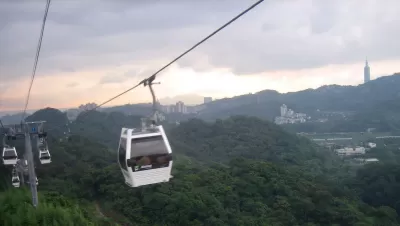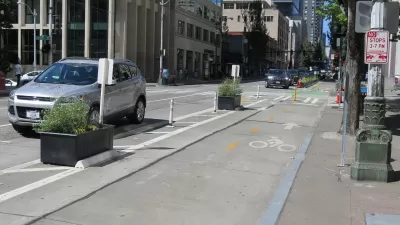Impatient with the city's light rail expansion plans, some residents are looking to aerial gondolas as a new mode of public transit.

A proposed aerial gondola could shuttle Seattle residents from downtown to West Seattle by 2024. The plan for the West Seattle SkyLink, proposed by a group of neighborhood activists, is gaining some traction as a possible alternative to existing light rail plans, which are currently projected to cost $600 million per mile and reach completion in 2031. Advocates hope to convince Sound Transit that the aerial gondola is a more cost-efficient option. The agency has reappropriated funds in the past: when safety concerns about tunneling for the Link light rail line stopped construction in 2005, the agency funded the First Hill line of the Seattle Streetcaras a replacement.
Used in some cities with challenging terrain, urban aerial gondolas can solve space issues in dense, hilly areas. In Colombia, Medellin's Metrocable system carries commuters over 9 miles of cable across the city's steep terrain. The SkyLink's proponents hope that they can convince Americans to support the technology, which, they say, could be less obtrusive and cause less displacement than other forms of transit and get built faster and more cheaply than light rail.
Opponents argue that the gondola's low passenger capacity, slower speed, and risk of inflated costs make it a much less efficient option. Citing the Medellin gondola's relatively low daily ridership, rail supporters claim that a comprehensive light rail network, planned with long-term expansion in mind, can serve more users more effectively safely than aerial gondolas.

Study: Maui’s Plan to Convert Vacation Rentals to Long-Term Housing Could Cause Nearly $1 Billion Economic Loss
The plan would reduce visitor accommodation by 25,% resulting in 1,900 jobs lost.

North Texas Transit Leaders Tout Benefits of TOD for Growing Region
At a summit focused on transit-oriented development, policymakers discussed how North Texas’ expanded light rail system can serve as a tool for economic growth.

Why Should We Subsidize Public Transportation?
Many public transit agencies face financial stress due to rising costs, declining fare revenue, and declining subsidies. Transit advocates must provide a strong business case for increasing public transit funding.

How Community Science Connects People, Parks, and Biodiversity
Community science engages people of all backgrounds in documenting local biodiversity, strengthening connections to nature, and contributing to global efforts like the City Nature Challenge to build a more inclusive and resilient future.

Alabama: Trump Terminates Settlements for Black Communities Harmed By Raw Sewage
Trump deemed the landmark civil rights agreement “illegal DEI and environmental justice policy.”

Dear Tesla Driver: “It’s not You, It’s Him.”
Amidst a booming bumper sticker industry, one writer offers solace to those asking, “Does this car make me look fascist?”
Urban Design for Planners 1: Software Tools
This six-course series explores essential urban design concepts using open source software and equips planners with the tools they need to participate fully in the urban design process.
Planning for Universal Design
Learn the tools for implementing Universal Design in planning regulations.
City of Santa Clarita
Ascent Environmental
Institute for Housing and Urban Development Studies (IHS)
City of Grandview
Harvard GSD Executive Education
Toledo-Lucas County Plan Commissions
Salt Lake City
NYU Wagner Graduate School of Public Service





























